Enhanced Sinterability, Thermal Conductivity and Dielectric Constant of Glass-Ceramics with PVA and BN Additions
Abstract
1. Introduction
2. Experimental Method
2.1. Preparation of Powders and Sintered Ceramics
2.2. Characterizations
3. Results and Discussion
4. Conclusions
Supplementary Materials
Author Contributions
Funding
Institutional Review Board Statement
Informed Consent Statement
Data Availability Statement
Acknowledgments
Conflicts of Interest
References
- Zhang, P.; Sun, K.; Wu, S.; Xiao, M. Microwave dielectric properties of low temperature co-fired ceramics LiMg1−xAxPO4 (A = Mn, Ca, 0.02 ≤ x ≤ 0.08). Mater. Lett. 2019, 255, 126565. [Google Scholar] [CrossRef]
- Yu, Y.; Hao, X.; Song, L.; Li, Z.; Song, L. Synthesis and characterization of single phase and low temperature co-fired cordierite glass-ceramics from perlite. J. Non-Cryst. Solids 2016, 448, 36–42. [Google Scholar] [CrossRef]
- Zitani, M.K.; Ebadzadeh, T.; Banijamali, S.; Riahifar, R.; Rüssel, C.; Abkenar, S.K.; Ren, H. High quality factor microwave dielectric diopside glass-ceramics for the low temperature co-fired ceramic (LTCC) applications. J. Non-Cryst. Solids 2018, 487, 65–71. [Google Scholar] [CrossRef]
- Qing, Z.; Li, B. Non-isothermal crystallization kinetics and properties of low temperature co-fired LiAlSi3O8-based glass-ceramics using zirconia additive. J. Non-Cryst. Solids 2018, 495, 1–7. [Google Scholar] [CrossRef]
- Li, H.; Huang, Z.; Cheng, L.; Kong, S.; Liu, S. Structure and dielectric properties of novel low temperature co-fired Bi2O3-RE2O3-MoO3 (RE = Pr, Nd, Sm, and Yb) based microwave ceramics. Ceram. Int. 2017, 43, 4570–4575. [Google Scholar] [CrossRef]
- Zhang, Z.; Tang, Y.; Li, J.; Chen, J.; Yang, A.; Wang, Y.; Zhai, Y.; Ao, L.; Su, C.; Xing, X.; et al. High-Q and near-zero τ composite Li2Mg2TiO5-Sr3(VO4)2 ceramics for low-temperature co-fired ceramic applications. Ceram. Int. 2020, 46, 8281–8286. [Google Scholar] [CrossRef]
- Tao, B.; Wang, W.; Liu, H.; Du, T.; Wu, H.; Xing, C.; Wang, D.; Zhang, Y. Low-temperature sintering LiF-doped Li4Mg3[Ti0.6(Mg1/3Nb2/3)0.4]2O9 microwave dielectric ceramics for LTCC applications. Ceram. Int. 2021, 47, 2584–2590. [Google Scholar] [CrossRef]
- Wu, J.; Li, Z.; Huang, Y.; Li, F.; Yang, Q. Fabrication and characterization of low temperature co-fired cordierite glass–ceramics from potassium feldspar. J. Alloy. Compd. 2014, 583, 248–253. [Google Scholar] [CrossRef]
- George, S.; Sebastian, M.T. Effect of lithium-based glass addition on the microwave dielectric properties of Ca[(Li1/3Nb2/3)1−xTix]O3−δ ceramics for LTCC applications. J. Alloy. Compd. 2009, 473, 336–340. [Google Scholar] [CrossRef]
- Bermejo, R.; Supancic, P.; Krautgasser, C.; Morrell, R.; Danzer, R. Subcritical crack growth in Low Temperature Co-fired Ceramics under biaxial loading. Eng. Fract. Mech. 2013, 100, 108–121. [Google Scholar] [CrossRef]
- Cui, X.; Zhou, J. A simple and an effective method for the fabrication of densified glass-ceramics of low temperature co-fired ceramics. Mater. Res. Bull. 2008, 43, 1590–1597. [Google Scholar] [CrossRef]
- Fernandes, J.; Barcelona, P.; Blanes, M.; Padilla, J.; Ramos, F.; Cirera, A.; Xuriguera, E. Study of mixing process of low temperature co-fired ceramics photocurable suspension for digital light processing stereolithography. Ceram. Int. 2021, 47, 15931–15938. [Google Scholar] [CrossRef]
- Yuan, L.; Liu, B.; Shen, N.; Zhai, T.; Yang, D. Synthesis and properties of borosilicate/AlN composite for low temperature co-fired ceramics application. J. Alloy. Compd. 2014, 593, 34–40. [Google Scholar] [CrossRef]
- Bermejo, R.; Supancic, P.; Kraleva, I.; Morrell, R.; Danzer, R. Strength reliability of 3D low temperature co-fired multilayer ceramics under biaxial loading. J. Eur. Ceram. Soc. 2011, 31, 745–753. [Google Scholar] [CrossRef]
- Jędrychowska, A.; Malecha, K.; Cabaj, J.; Sołoducho, J. Laccase biosensor based on low temperature co-fired ceramics for the permanent monitoring of water solutions. Electrochim. Acta 2015, 165, 372–382. [Google Scholar] [CrossRef]
- Malecha, K.; Maeder, T.; Jacq, C.; Ryser, P. Structuration of the low temperature co-fired ceramics (LTCC) using novel sacrificial graphite paste with PVA–propylene glycol–glycerol–water vehicle. Microelectron. Reliab. 2011, 51, 805–811. [Google Scholar] [CrossRef]
- Huang, C.-L.; Chu, T.-M.; Tsai, M.-H. A low-loss, low temperature sintering dielectric using Ba1-SrMg2(VO4)2 ceramics and its applications at microwave frequencies. Mater. Sci. Eng. B 2021, 268, 115114. [Google Scholar] [CrossRef]
- Baeza, M.; López, C.; Alonso, J.; López-Santín, J.; Alvaro, G. Ceramic Microsystem Incorporating a Microreactor with Immobilized Biocatalyst for Enzymatic Spectrophotometric Assays. Anal. Chem. 2010, 82, 1006–1011. [Google Scholar] [CrossRef]
- Zhou, H.; Wang, K.; Sun, W.; Chen, X.; Ruan, H. Phase composition, singtering behavior and microwave dielectric properties of M2BiLi2V3O12 (M = Zn, Ca) low temperature co-fired ceramics. Mater. Lett. 2018, 217, 20–22. [Google Scholar] [CrossRef]
- Li, J.; Su, H.; Sun, Y.; Wang, G.; Gao, F.; Han, X.; Liang, Z.; Li, Q. Enhancement of structural and microwave properties of Zn2+ ion-substituted Li2MgSiO4 ceramics for LTCC applications. Ceram. Int. 2021, 47, 15039–15043. [Google Scholar] [CrossRef]
- Zhang, Q.-L.; Zou, D.; Yang, H. Microwave dielectric properties of Ba3Ti4−x(Zn1/3Nb2/3)xNb4O21 for low temperature co-fired ceramics. J. Eur. Ceram. Soc. 2011, 31, 265–272. [Google Scholar] [CrossRef]
- Shigeno, K.; Li, M.; Fujimori, H. Development of novel temperature-stable Al2O3–TiO2-based dielectric ceramics featuring superior thermal conductivity for LTCC applications. J. Eur. Ceram. Soc. 2021, 41, 376–386. [Google Scholar] [CrossRef]
- Krautgasser, C.; Danzer, R.; Deluca, M.; Supancic, P.; Aldrian, F.; Bermejo, R. Subcritical crack growth in multilayer Low Temperature Co-fired Ceramics designed with surface compressive stresses. J. Eur. Ceram. Soc. 2016, 36, 4095–4105. [Google Scholar] [CrossRef]
- Xia, Y.; Hu, Y.; Ren, L.; Luo, X.; Gong, W.; Zhou, H. Manufacturing a high performance film of CaO-B2O3-SiO2 glass-ceramic powder with surface modification for LTCC application. J. Eur. Ceram. Soc. 2018, 38, 253–261. [Google Scholar] [CrossRef]
- Kumari, P.; Tripathi, P.; Parkash, O.; Kumar, D. Low Temperature Sintering and Characterization of MgO-B2O3-SiO2 Glass-Ceramics for LTCC Substrate Applications. Trans. Indian Ceram. Soc. 2016, 75, 229–233. [Google Scholar] [CrossRef]
- Qing, Z. The effects of B2O3 on the microstructure and properties of lithium aluminosilicate glass-ceramics for LTCC applications. Mater. Lett. 2018, 212, 126–129. [Google Scholar] [CrossRef]
- Shao, H.; Wang, T.; Zhang, Q. Preparation and properties of CaO–SiO2–B2O3 glass-ceramic at low temperature. J. Alloy. Compd. 2009, 484, 2–5. [Google Scholar] [CrossRef]
- Chang, C.-R.; Jean, J.-H. Crystallization Kinetics and Mechanism of Low-Dielectric, Low-Temperature, Cofirable CaO-B2O3-SiO2Glass-Ceramics. J. Am. Ceram. Soc. 1999, 82, 1725–1732. [Google Scholar] [CrossRef]
- Chen, G.-H. Sintering, crystallization, and properties of CaO doped cordierite-based glass–ceramics. J. Alloy. Compd. 2008, 455, 298–302. [Google Scholar] [CrossRef]
- Kemethmuller, S.; Roosen, A.; Goetz-Neunhoeffer, F.; Neubauer, J. Quantitative Analysis of Crystalline and Amorphous Phases in Glass–Ceramic Composites Like LTCC by the Rietveld Method. J. Am. Ceram. Soc. 2006, 89, 2632–2637. [Google Scholar] [CrossRef]
- Hamzawy, E.; El-Kheshen, A.; Zawrah, M. Densification and properties of glass/cordierite composites. Ceram. Int. 2005, 31, 383–389. [Google Scholar] [CrossRef]
- Lima, M.; Monteiro, R.; Graça, M.; da Silva, M.F. Structural, electrical and thermal properties of borosilicate glass–alumina composites. J. Alloy. Compd. 2012, 538, 66–72. [Google Scholar] [CrossRef]
- Sun, Z.; Li, W.; Liu, Y.; Zhang, H.; Zhu, D.; Sun, H.; Hu, C.; Chen, S. Design and preparation of a novel degradable low-temperature co-fired ceramic (LTCC) composites. Ceram. Int. 2019, 45, 7001–7010. [Google Scholar] [CrossRef]
- Ma, M.; Liu, Z.; Li, Y.; Zeng, Y.; Yao, D. Enhanced thermal conductivity of low-temperature sintered borosilicate glass–AlN composites with β-Si3N4 whiskers. J. Eur. Ceram. Soc. 2013, 33, 833–839. [Google Scholar] [CrossRef]
- Luo, X.; Ren, L.; Xia, Y.; Hu, Y.; Gong, W.; Cai, M.; Zhou, H. Microstructure, sinterability and properties of CaO-B2O3-SiO2glass/Al2O3 composites for LTCC application. Ceram. Int. 2017, 43, 6791–6795. [Google Scholar] [CrossRef]
- Chiang, T.H.; Hsieh, T.-E. A Study of Encapsulation Resin Containing Hexagonal Boron Nitride (hBN) as Inorganic Filler. J. Inorg. Organomet. Polym. Mater. 2006, 16, 175–183. [Google Scholar] [CrossRef]
- Xu, C.; Li, E.; Zeng, J.; Wang, Y.; Wang, T.; Ge, C.; Zhang, C.; Wang, Q.; Gao, T.; Yao, Y.; et al. Interfacial thermal conductance enhancement of BN/PVA composites via plasma activations of fillers. Compos. Commun. 2021, 28, 100963. [Google Scholar] [CrossRef]
- Hasanuzzaman, M.; Rafferty, A.; Sajjia, M.; Olabi, A.-G. Properties of Glass Materials. In Reference Module in Materials Science and Materials Engineering; Hashmi, S., Ed.; Elsevier: Amsterdam, The Netherlands, 2016; pp. 1–12. [Google Scholar] [CrossRef]
- Guo, Q.; Li, L.; Yu, S.; Sun, Z.; Zheng, H.; Luo, W. Temperature–stable dielectrics based on Ni–doped Bi2Zn2/3Nb4/3O7 pyrochlore ceramics for low temperature co-fired ceramic. J. Alloy. Compd. 2018, 767, 259–263. [Google Scholar] [CrossRef]
- Liu, J.; Luo, Z.; Lin, C.; Han, L.; Gui, H.; Song, J.; Liu, T.; Lu, A. Influence of Y2O3 substitution for B2O3 on the structure and properties of alkali-free B2O3-Al2O3-SiO2 glasses containing alkaline-earth metal oxides. Phys. B: Condens. Matter 2019, 553, 47–52. [Google Scholar] [CrossRef]
- Akkasoglu, U.; Sengul, S.; Arslan, I.; Ozturk, B.; Cicek, B. Structural, thermal and dielectric properties of low-alkali borosilicate glasses for electronic applications. J. Mater. Sci. Mater. Electron. 2021, 32, 22629–22636. [Google Scholar] [CrossRef]
- Feng, X.; Lv, Y.; Zhang, L.; Ding, J.; Sun, J.; Li, X.; Chen, L.; Zheng, K.; Zhang, X.; Tian, X. High Performance of Low-Temperature-Cofired Ceramic with Al2O3/BN Biphasic Ceramics Based on B2O3–Bi2O3–SiO2–ZnO Glass. Adv. Eng. Mater. 2020, 22, 1–10. [Google Scholar] [CrossRef]
- Sonnick, S.; Meier, M.; Ross-Jones, J.; Erlbeck, L.; Medina, I.; Nirschl, H.; Rädle, M. Correlation of pore size distribution with thermal conductivity of precipitated silica and experimental determination of the coupling effect. Appl. Therm. Eng. 2019, 150, 1037–1045. [Google Scholar] [CrossRef]
- Šveda, M.; Janík, B.; Pavlík, V.; Štefunková, Z.; Pavlendová, G.; Šín, P.; Sokolář, R. Pore-size distribution effects on the thermal conductivity of the fired clay body from lightweight bricks. J. Build. Phys. 2016, 41, 78–94. [Google Scholar] [CrossRef]
- Skibinski, J.; Cwieka, K.; Ibrahim, S.H.; Wejrzanowski, T. Influence of Pore Size Variation on Thermal Conductivity of Open-Porous Foams. Mater. 2019, 12, 2017. [Google Scholar] [CrossRef]
- Yamamoto, J.K.; Kata, K.; Shimada, Y. Fabrication of controlled porosity in a tape cast glass ceramic substrate material. Mater. Lett. 1989, 8, 278–282. [Google Scholar] [CrossRef]
- Kata, K.; Shimada, Y. Low Dielectric Constant Glass-Ceramic Composite Controled Isolated Porosity. J. Ceram. Soc. Jpn. 1992, 100, 570–576. [Google Scholar] [CrossRef][Green Version]
- Bilaç, O.; Duran, C. Al2O3/glass/hBN composites with high thermal conductivity and low dielectric constant for low temperature cofired ceramic applications. J. Asian Ceram. Soc. 2021, 9, 283–290. [Google Scholar] [CrossRef]
- Sebastian, M.T. Dielectric Materials for Wireless Communication; Elsevier: Amsterdam, The Netherlands, 2008; Available online: https://books.google.com.tr/books?id=NpX6nQEACAAJ (accessed on 9 November 2021).
- Zhou, J. Towards rational design of low-temperature co-fired ceramic (LTCC) materials. J. Adv. Ceram. 2012, 1, 89–99. [Google Scholar] [CrossRef]
- Sebastian, M.T.; Ubic, R.; Jantunen, H. Microwave Materials and Applications, 2 Volume Set; John Wiley & Sons: Hoboken, NJ, USA, 2017; Available online: https://books.google.com.tr/books?id=cjxGDgAAQBAJ (accessed on 9 November 2021).


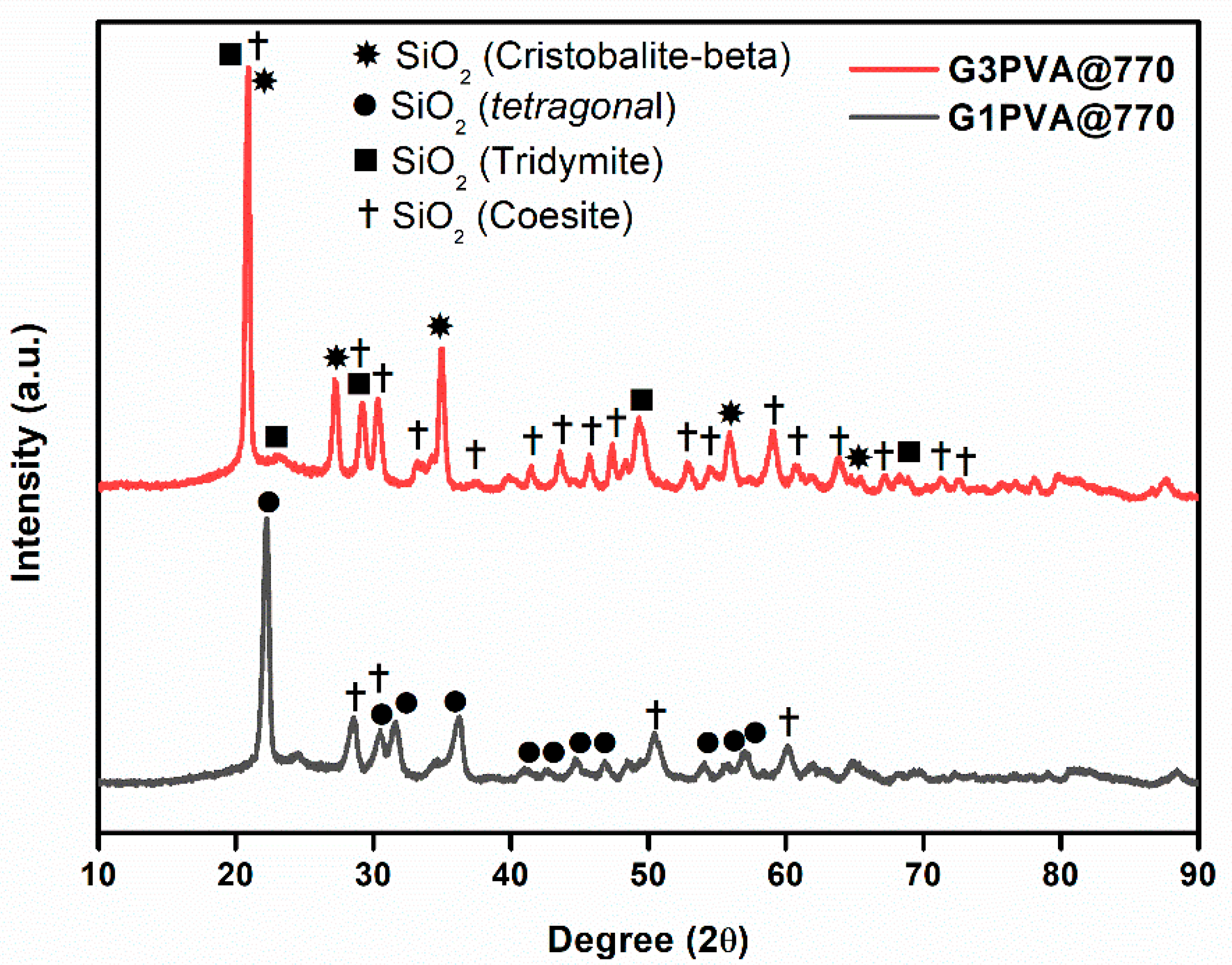
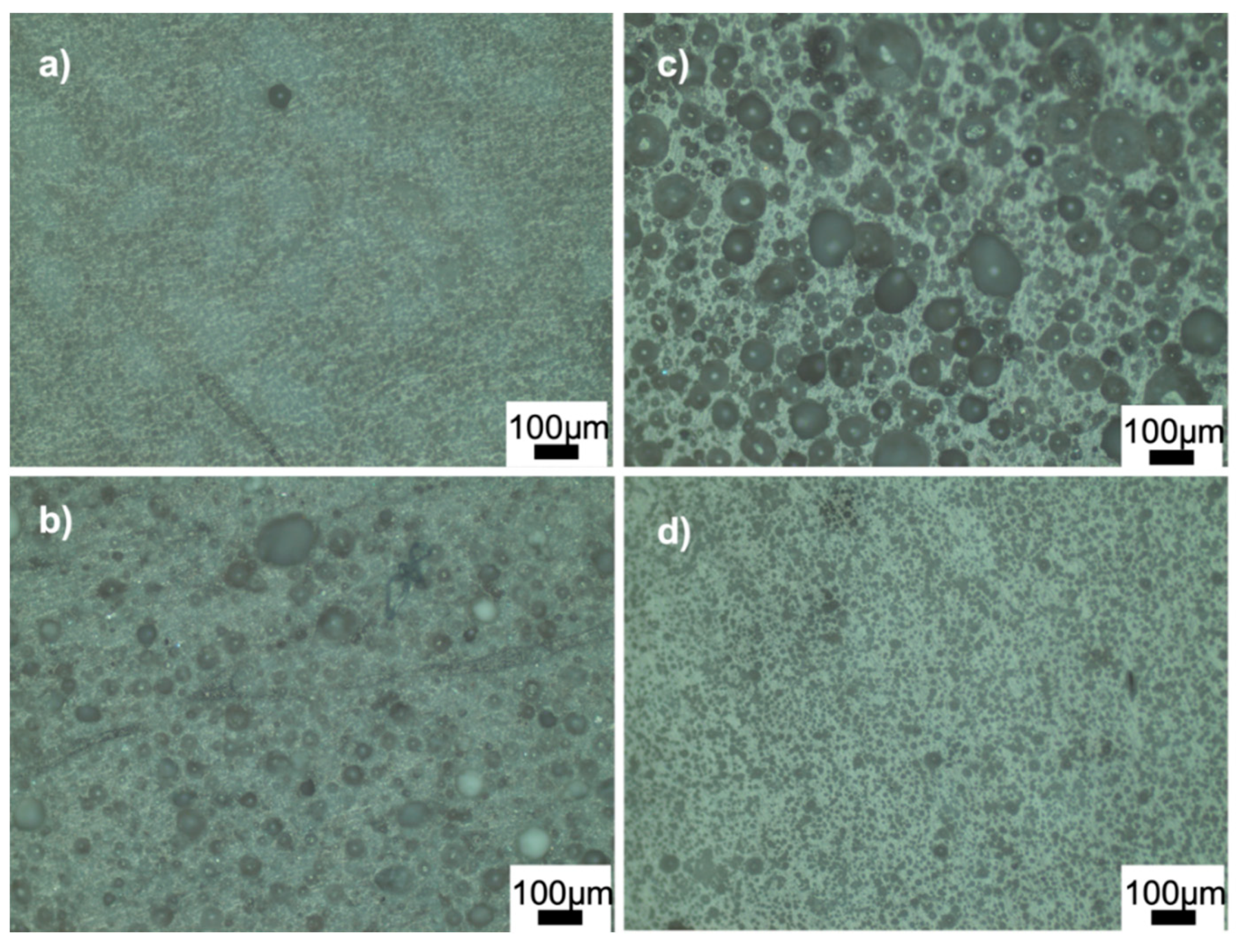
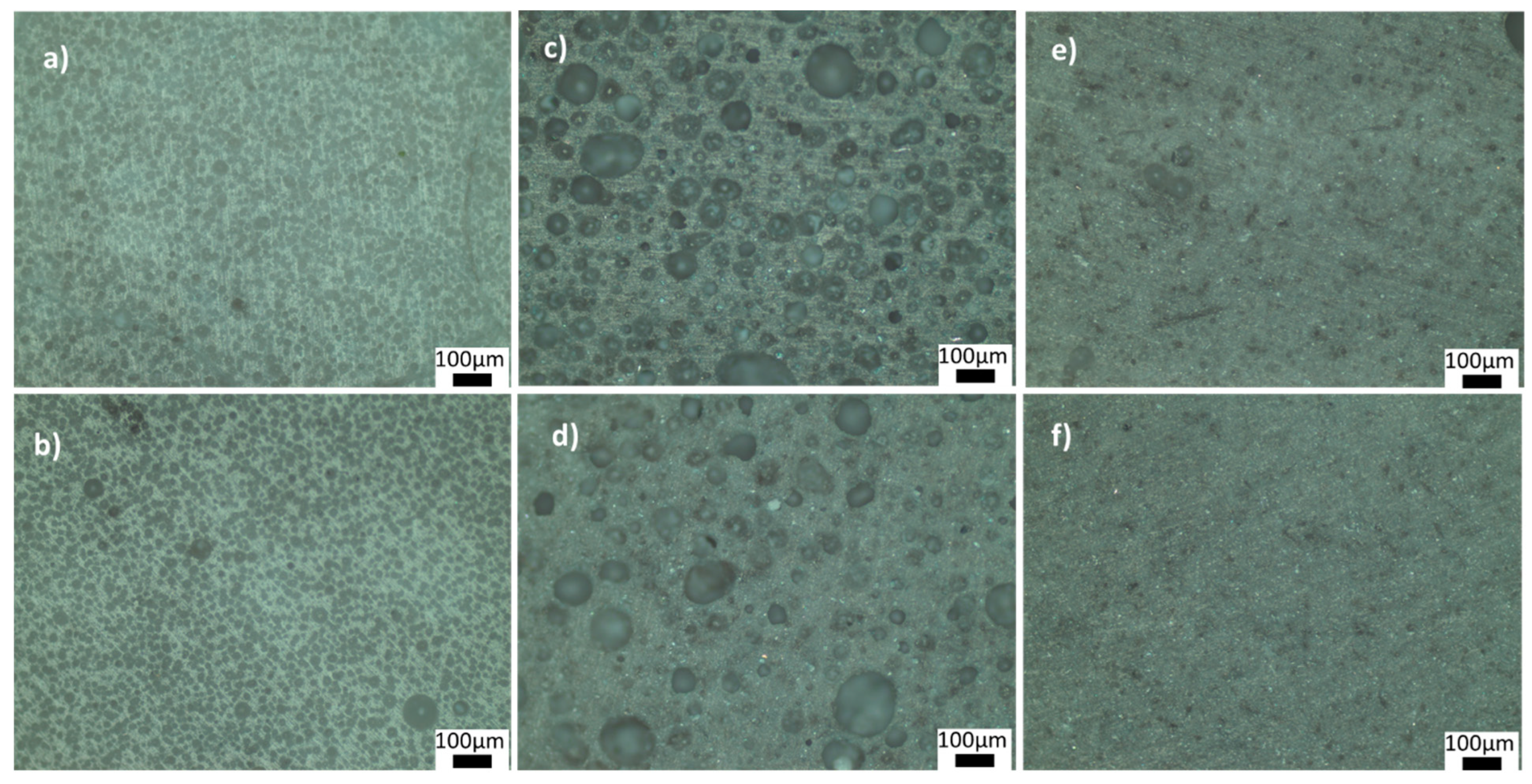
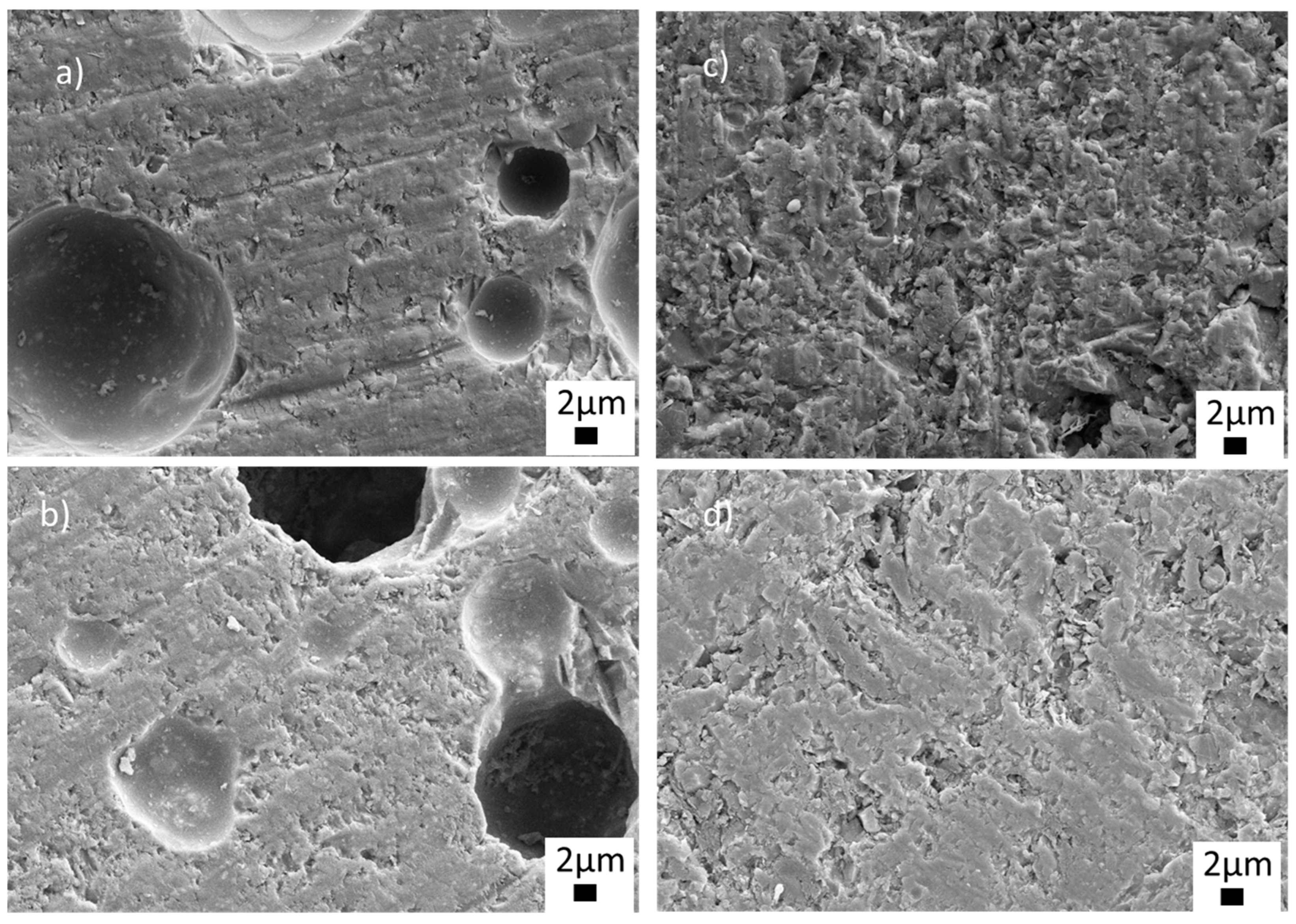
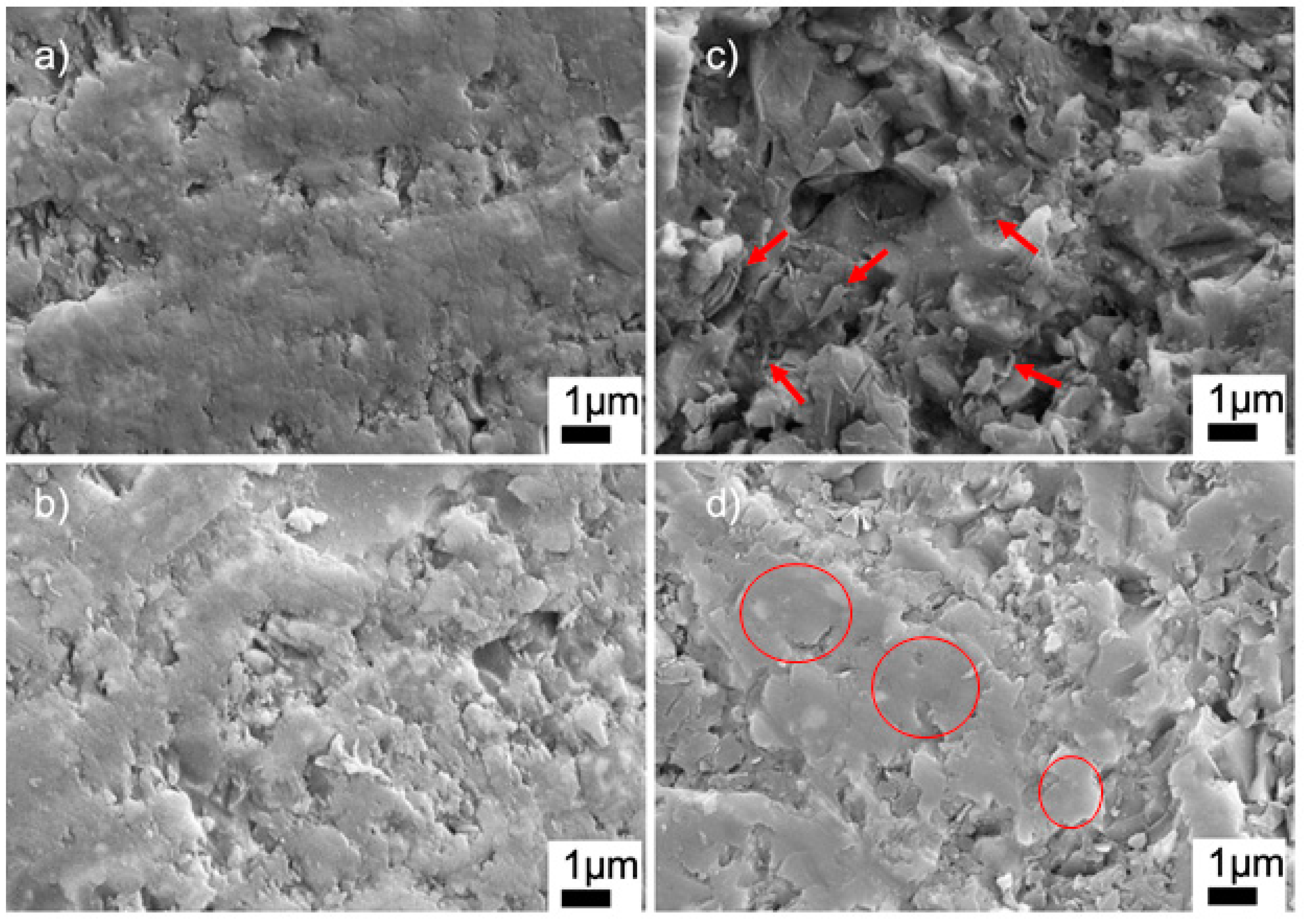
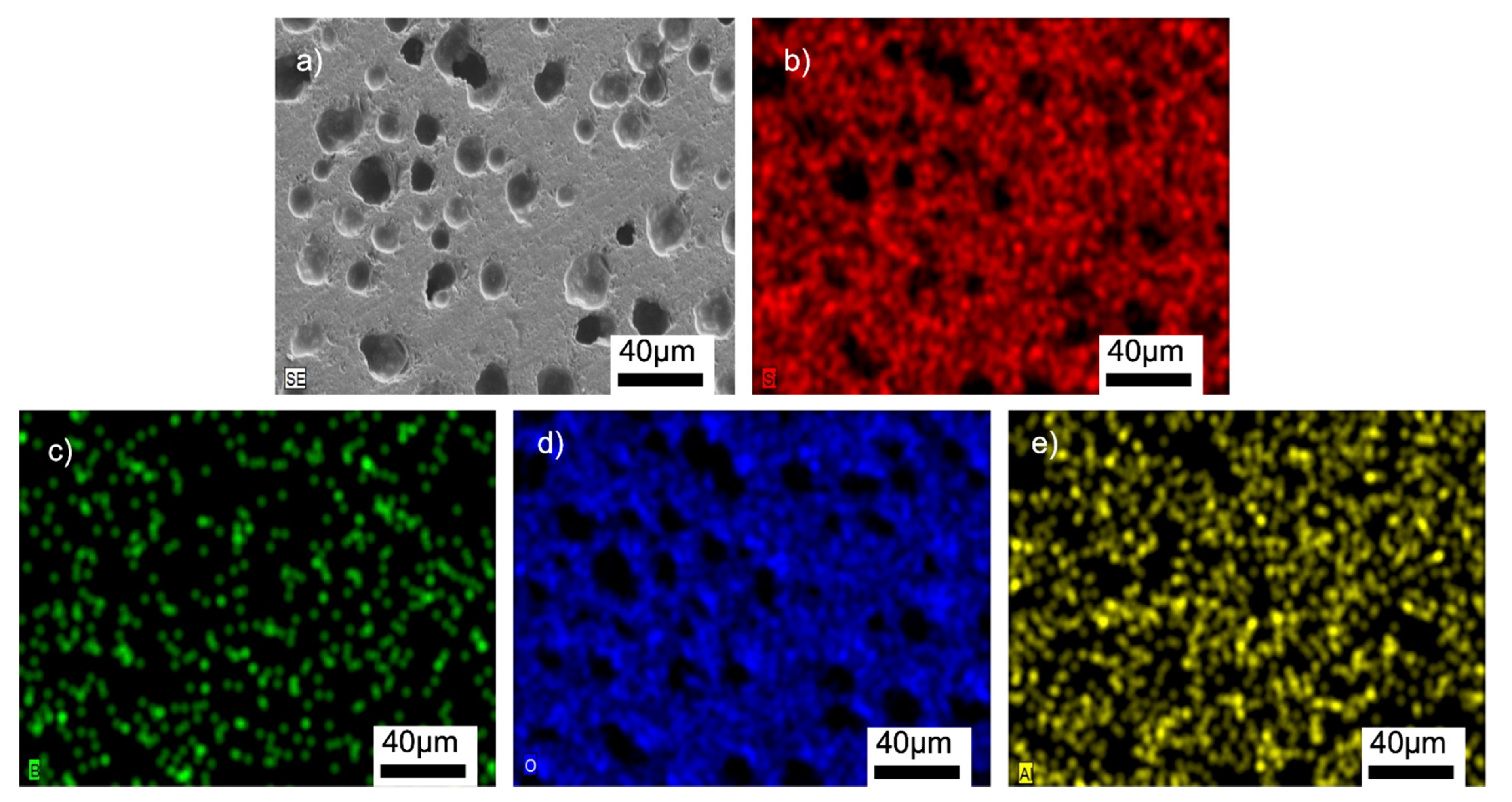
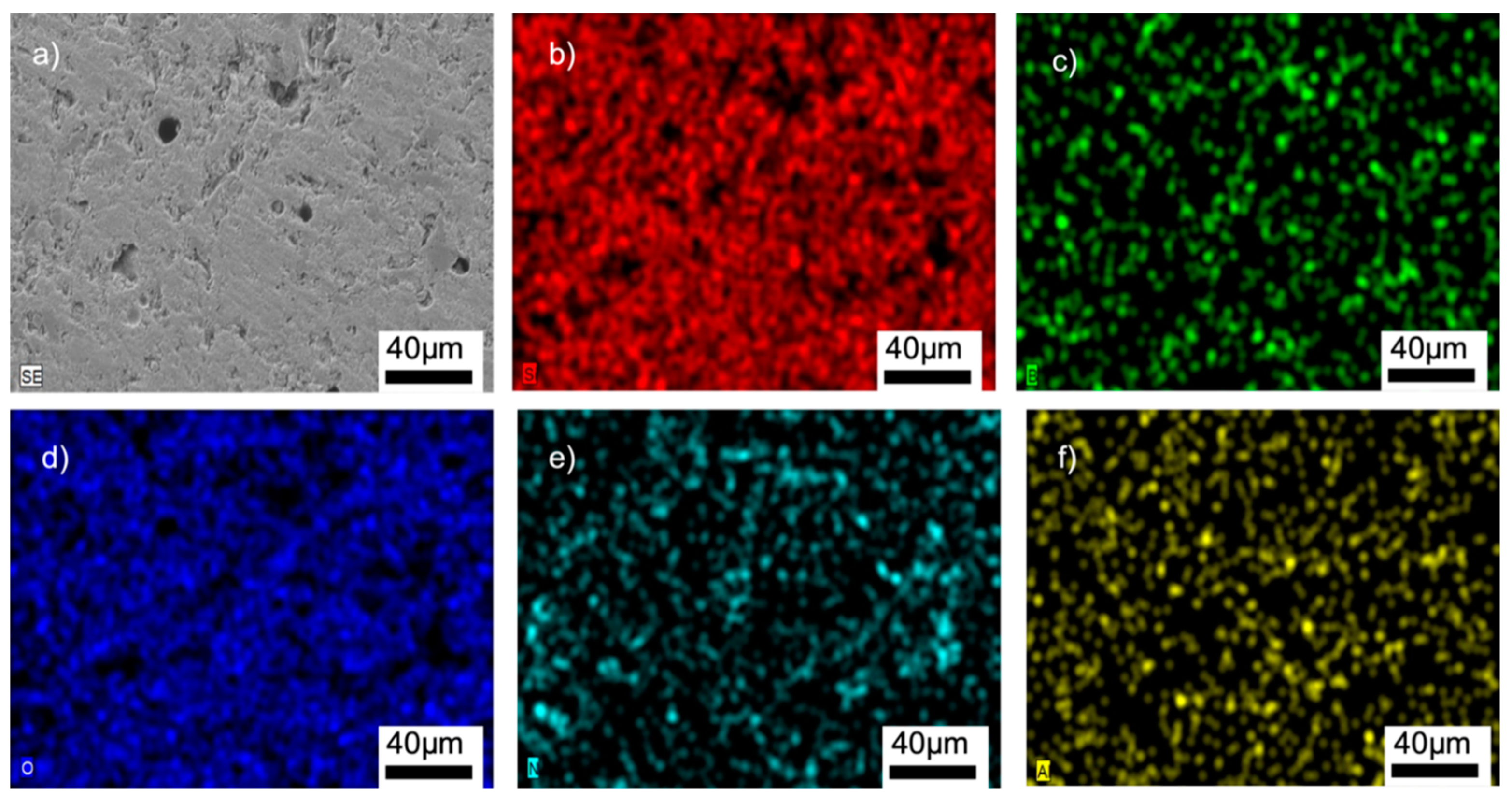
| Sample Name | % of Glass Powder | % of BN | % of PVA | Sintering Temperature (°C) |
|---|---|---|---|---|
| G3BN@770 | 97 | 3 | - | 770 |
| G6BN@770 | 94 | 6 | - | 770 |
| G9BN@770 | 91 | 9 | - | 770 |
| G12BN@770 | 88 | 12 | - | 770 |
| G1PVA@770 | 99 | - | 1 | 770 |
| G3PVA@770 | 97 | - | 3 | 770 |
| G@770 | 100 | - | - | 770 |
| G@720 | 100 | - | - | 720 |
| G1PVA@720 | 99 | - | 1 | 720 |
| G3BN@720 | 97 | 3 | - | 720 |
| G6BN@720 | 94 | 6 | - | 720 |
| Sample Name | Average Archimedes Density (g/cm3) | Relative Archimedes Density (%) | Apparent Porosity (%) | Open Porosity (%) |
|---|---|---|---|---|
| G3BN@770 | 1.508 ± 0.002 | 74.75 | 13.5 | 0.91 |
| G6BN@770 | 1.524 ± 0.002 | 75.25 | 11.9 | 0.25 |
| G9BN@770 | 1.733 ± 0.001 | 85.64 | 9.0 | 0.14 |
| G12BN@770 | 2.100 ± 0.002 | 103.96 | 2.6 | 0.08 |
| G1PVA@770 | 1.773 ± 0.000 | 87.62 | 12.2 | 0.04 |
| G3PVA@770 | 1.770 ± 0.003 | 87.62 | 9.5 | 0.13 |
| G@770 | 1.769 ± 0.002 | 87.12 | 13.7 | 0.11 |
| G@720 | 1.938 ± 0.005 | 96.04 | 10.7 | 0.07 |
| G1PVA@720 | 1.904 ± 0.001 | 94.06 | 14.6 | 0.51 |
| G3BN@720 | 1.402 ± 0.010 | 69.30 | 8.98 | 1.27 |
| G6BN@720 | 1.662 ± 0.002 | 82.18 | 13.53 | 0.99 |
| Sample Name | Diffusivity (mm2/s) | Standard Deviation (mm2/s) | Thermal Conductivity (W/K.m) |
|---|---|---|---|
| G3BN@770 | 0.911 | 0.012 | 1.729 ± 0.02 |
| G6BN@770 | 1.395 | 0.006 | 2.620 ± 0.01 |
| G9BN@770 | 1.191 | 0.005 | 2.570 ± 0.01 |
| G12BN@770 | 1.466 | 0.002 | 3.955 ± 0.01 |
| G1PVA@770 | 0.954 | 0.022 | 2.107 ± 0.05 |
| G3PVA@770 | 1.113 | 0 | 2.453 ± 0.00 |
| G@770 | 0.676 | 0.004 | 1.489 ± 0.01 |
| G@720 | 0.670 | 0.007 | 1.617 ± 0.02 |
| G1PVA@720 | 0.591 | 0.006 | 1.401 ± 0.01 |
| G3BN@720 | 0.785 | 0.003 | 1.371 ± 0.01 |
| G6BN@720 | 0.459 | 0.005 | 0.950 ± 0.01 |
| Sample Name | Dielectric Constant (@ 5 MHz) | Dielectric Loss (@ 5 MHz) |
|---|---|---|
| G@770 | 2.42 ± 0.1 | 0.2025 ± 0.01 |
| G3BN@770 | 3.84 ± 0.1 | 0.1068 ± 0.01 |
| G6BN@770 | 4.43 ± 0.1 | 0.0373 ± 0.01 |
| G9BN@770 | 2.84 ± 0.1 | 0.0272 ± 0.01 |
| G12BN@770 | 3.00 ± 0.1 | 0.0388 ± 0.01 |
| G1PVA@770 | 2.40 ± 0.1 | 0.0296 ± 0.01 |
| G3PVA@770 | N/A | N/A |
Publisher’s Note: MDPI stays neutral with regard to jurisdictional claims in published maps and institutional affiliations. |
© 2022 by the authors. Licensee MDPI, Basel, Switzerland. This article is an open access article distributed under the terms and conditions of the Creative Commons Attribution (CC BY) license (https://creativecommons.org/licenses/by/4.0/).
Share and Cite
Arıbuğa, D.; Akkaşoğlu, U.; Çiçek, B.; Balcı-Çağıran, Ö. Enhanced Sinterability, Thermal Conductivity and Dielectric Constant of Glass-Ceramics with PVA and BN Additions. Materials 2022, 15, 1685. https://doi.org/10.3390/ma15051685
Arıbuğa D, Akkaşoğlu U, Çiçek B, Balcı-Çağıran Ö. Enhanced Sinterability, Thermal Conductivity and Dielectric Constant of Glass-Ceramics with PVA and BN Additions. Materials. 2022; 15(5):1685. https://doi.org/10.3390/ma15051685
Chicago/Turabian StyleArıbuğa, Dilara, Ufuk Akkaşoğlu, Buğra Çiçek, and Özge Balcı-Çağıran. 2022. "Enhanced Sinterability, Thermal Conductivity and Dielectric Constant of Glass-Ceramics with PVA and BN Additions" Materials 15, no. 5: 1685. https://doi.org/10.3390/ma15051685
APA StyleArıbuğa, D., Akkaşoğlu, U., Çiçek, B., & Balcı-Çağıran, Ö. (2022). Enhanced Sinterability, Thermal Conductivity and Dielectric Constant of Glass-Ceramics with PVA and BN Additions. Materials, 15(5), 1685. https://doi.org/10.3390/ma15051685







